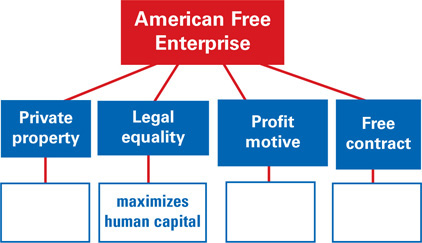Chapter 3 Assessment
Chapter Summary
A summary of major ideas in Chapter 3 appears below. See also the Guide to the Essentials of Economics, which provides additional review and test practice of key concepts in Chapter 3.
-
Section 1 Benefits of Free Enterprise (pp. 51–55)
The benefits of the American free enterprise system are the result of the basic principles of profit motive, voluntary exchange, private property rights, and competition. These benefits include individual freedom for consumers and producers and a wide variety of goods. To protect economic freedoms, the government intervenes in matters of public interest. Federal agencies monitor and regulate certain types of businesses. Public disclosure laws provide critical information to consumers.
-
Section 2 Promoting Growth and Stability (pp. 57–60)
Macroeconomics concerns the behavior of whole economies, while microeconomics concerns the behavior of smaller economic units, such as households. When necessary, the government takes action to influence macroeconomic business cycles. It aids the growth of the economy, as measured by GDP. It encourages the creation of new technologies by giving patents and copyrights to entrepreneurs.
-
Section 3 Providing Public Goods (pp. 62–66)
The government provides public goods, such as roads, when it would be impractical for individuals to pay for them. Providing public goods produces positive and negative externalities.
-
Section 4 Providing a Safety Net (pp. 67–70)
The government uses tax money to raise the standard of living of people in poverty. The nation's welfare system includes programs that distribute various benefits, including cash transfers, in-kind payments, and medical benefits.
Key Terms
Choose the italicized word in parentheses that best completes each sentence.
- Acid rain is an example of a(n) (externality/free rider).
- The tradition of (private property/open opportunity) allows everyone to compete in the free market.
- The right of (free contract/voluntary exhange) allows people to decide what agreements they want to enter into.
- Someone who benefits from a good without paying for it is an example of a (free rider/public good).
- Food stamps are an example of a/an (cash transfer/in-kind payment).
- We can use figures on (gross domestic product/public goods) to measure economic growth.
- Study of the behavior of the entire U.S. economy is an example of (macroeconomics/microeconomics).
Using Graphic Organizers
- On a separate sheet of paper, copy the tree map below to help you organize information about the American free enterprise system. Complete the tree map by writing descriptions and examples for each of the headings shown. You may add branches to the tree.





